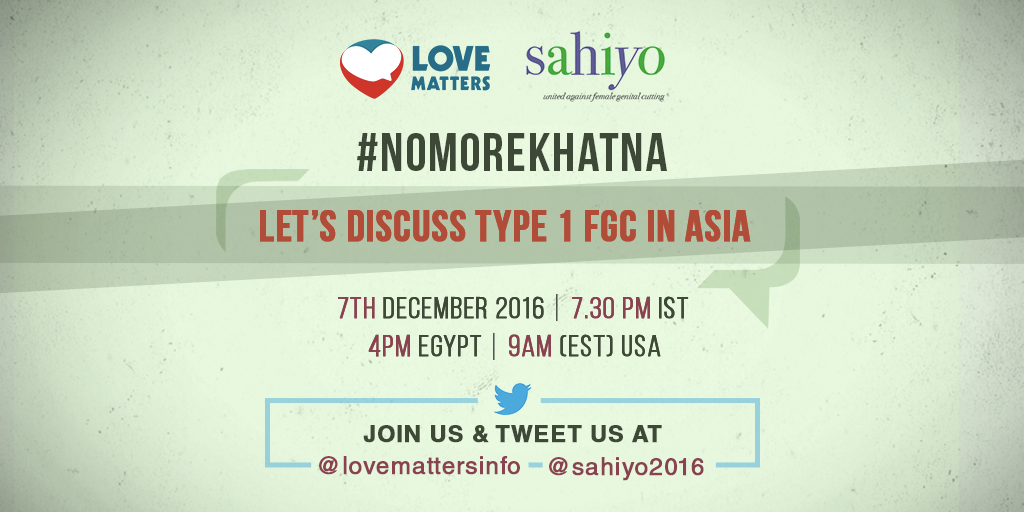We must realise that there is an alternative to khatna

by Insia Jaliwala Age: 18 Country: India The experience of khatna, not only the actual act but the implications of the practice, was a gradual revelation for me. In the vague haze of childhood memories, that particular day stands out. I must have been around 6 or 7 years old. My parents told me I could miss school that day and were taking me out, I was obviously very ecstatic. I was taken to a ‘lady doctor’; a gynecologist who applied a red serum on my hand with a cotton bud and asked if it burned. It did. She then proceeded to do the same to my genitalia. I remember the moment when she told me to remove my pants and lie down on the bed. “It’ll be over in a minute,” she said while holding a scalpel in her hand. There wasn’t much bleeding and I don’t even remember the pain. What I do remember is an inhibiting confusion and fear. That day isn’t registered in my memory as a traumatic event, but a day I associate with a sense of loss. That day an important part of my womanhood was snatched away from me. That day my body was mutilated without my consent. The reality of the twisted practice struck me only a few years ago when I got into a conversation with my elder sister who told me about her experience, which was much worse and painful. After, I started to explore the subject more. I read about female circumcision and came across horrifying stories from Africa. I stumbled into many stories of khatna told by the women around me. I had started to understand the terrifying implications of the practice which differed from person to person and the physical and mental trauma some of my own sisters and close friends had to go through, and are still going through. I also came across many justifications for the practice, some from my family elders which went along the lines of, “This is done to curb a girl’s sexual desire so that she can put her mind to other things”, among many others. All of this left me with an overwhelming sense of betrayal. My family, my community, had failed me. As I dwelled into it more, I realized that this act of oppression had (as with any other social issue or phenomenon) multiple dimensions and was woven in a convoluted fabric of culture, custom, and tradition. Earlier this year, as a film project for college, I decided to make a documentary on Khatna. During my research for the film, I came across Sahiyo and was amazed by the fact that so many women were willing to share their stories on this platform. My initial thought when I decided to make the film was that no woman would want to talk about this on camera. To my surprise and glee, many women around me agreed to be a part of it. There are hundreds of women (and men) out there who want this barbaric practice to stop. There needs to be a discussion about this on a communal level and people of the community need to realise that they have an alternative, they can choose not to impose this upon their young ones.
Dec 7: Join our Twitter chat on Type 1 Female Genital Cutting in Asia

Female Genital Cutting is practiced in many different ways, some less severe than others. But is a woman’s experience of such a ritual any less significant if the cutting was “mild”? Love Matters India and Sahiyo would love to discuss this question – and many others – with all of you in a Twitter Chat on Wednesday, December 7, 2016. Timings: The Twitter Chat begins at 7.30 pm IST (India and Sri Lanka) 9 am EST (US east coast) 4 pm in Egypt 10 pm in Singapore and Malaysia Here is how you can participate: Log into your Twitter account (or make one, if you are not on Twitter yet!) Follow the handles @lovemattersinfo and @sahiyovoices Respond to our questions and tweets about Type I FGC Remember to use the hashtag #NoMoreKhatna in all your tweets! Why this discussion is important: According to United Nations statistics, at least 200 million girls from 30 countries around the world have been subjected to Female Genital Cutting / Mutilation (FGC/M), a practice that involves cutting away varying degrees of the female genitalia. The World Health Organisation classifies FGC into four types, depending on how severe the cut is. For decades, activists, researchers, funders, and the media have focused mainly on Types II and III, the most severe forms of genital cutting. Type I, however, has often been overlooked. This form involves cutting the clitoral hood, and/or part or all of the clitoris, and it is prevalent in a number of Asian communities, including the Dawoodi Bohras and Malay Muslims. All too often, concerns about this “mild” form of genital cutting are dismissed as overreactions. “It is just a small nick, a small slice of skin,” we are told. “It is not the same as the mutilation done in Africa,” they say. We believe it is time to re-examine these notions about Type I FGC, to give voice to those who have been affected, and to recognise that even the least severe genital cuts are still a form of gender violence. And as a prequel to the Twitter Chat, do watch this video by Love Matters India and director Priya Goswami, featuring Bohra voices of resistance to Type I FGC: [youtube url=”https://youtu.be/A5F6OT5vwwY”]
